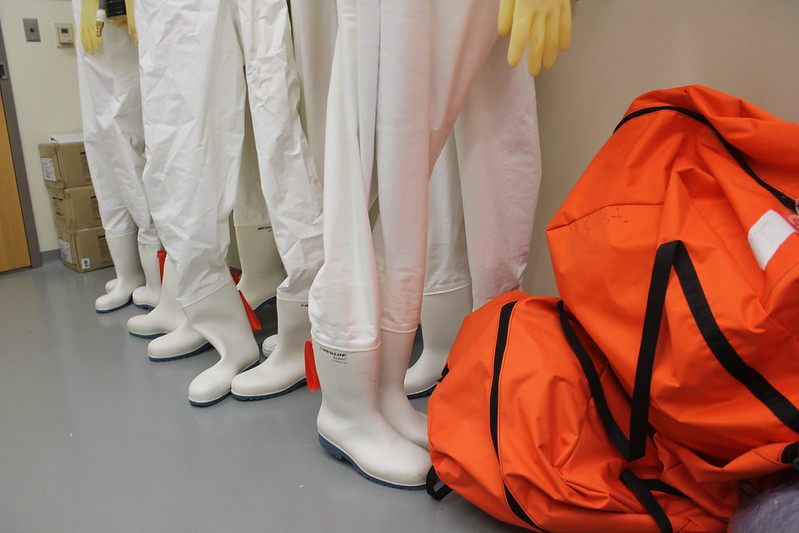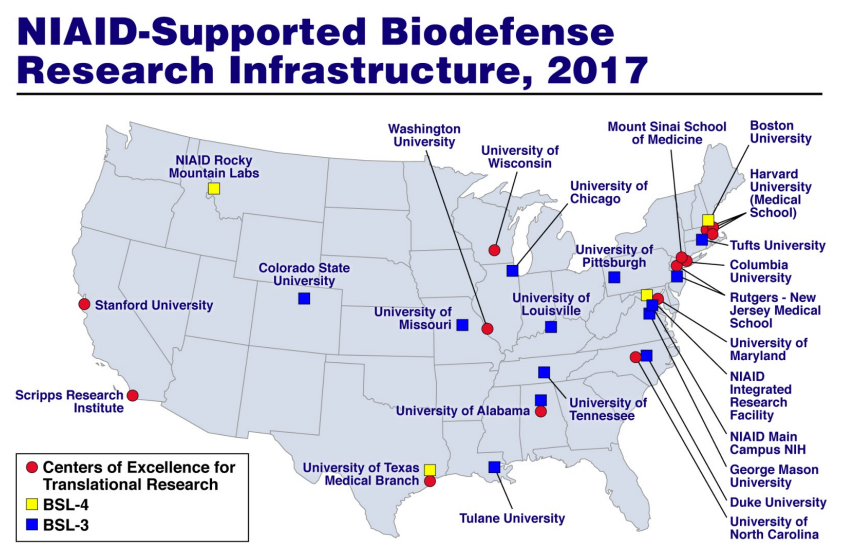
Anthony Fauci detailed how the research portfolio of his longtime former institute, the National Institute of Allergy and Infectious Diseases, did not distinguish between “biodefense efforts” and “naturally occurring” pathogens in a fall 2017 presentation, according to emails obtained by U.S. Right to Know.
Fauci described “the joining with and ultimate indistinguishing of biodefense efforts and efforts directed at naturally occurring emerging and re-emerging infections,” according to his preview of the presentation.
NIAID’s blending of bioterrorism defense and emerging infectious diseases research has long generated debate in the scientific community, especially insofar as it brought a rise in high security labs and high risk research.
“Gain-of-function” research (GOF) makes viruses more pathogenic or transmissible. Much of this gain-of-function research is considered “dual use research of concern” (DURC) because it can be applied toward benevolent civilian aims or misapplied toward the development of bioweapons.
The new emails provide another window into the thinking of the government official most responsible for U.S. policy on maximum security labs and gain-of-function research — Fauci himself.
More details about the presentation come from James Le Duc, former director of the maximum security Galveston National Laboratory, who invited Fauci to give the talk as part of a forum for students on national defense. He described Fauci’s presentation as having drawn a connection between zoonotic and laboratory threats.
“Your talk was perfect in summarizing the importance of the role that academia has played in contributing to the defense of the Nation against threats of bioterrorism,” Le Duc said. “The linkage you drew between naturally occurring and manmade threats from infectious diseases was especially relevant, as was your summary of the evolution of the NIAID programs in biodefense and emerging infectious diseases.”
Fauci’s biodefense legacy has taken on a new significance in light of the COVID-19 pandemic. Critics, especially those who believe the pandemic is likely to have resulted from a lab accident, say the global proliferation of maximum security labs and GOF/DURC has made the world less safe.
‘Nature may be the worst bioterrorist’
After the 2001 anthrax attacks, amid concerns about alleged “weapons of mass destruction,” including biological weapons, in Iraq, former President George W. Bush asked Congress to invest billions in building maximum security labs capable of combating bioterrorism.
Counter-bioterrorism research at the National Institutes for Health surged from $53 million in 2001 to at least $1.6 billion in 2004, and included plans for 11 new high containment laboratories, a Bush-era fact sheet shows.
“NIH will lead a partnership with industry, academia, and government agencies dedicated to understanding the pathogenesis of potential bioterrorism agents and to translating this knowledge into required medical products,” another fact sheet reads.
On September 30, 2004, the Iraq Survey Group released a report concluding that at the time of the 2003 invasion, Iraq no longer had a biological weapons program, and had abandoned plans to preserve or revive its earlier biological weapons program in the mid-1990s. Yet the U.S. biodefense boom continued and the labs were constructed.
Fauci harnessed the new resources toward combatting naturally emerging infectious diseases.
According to Fauci’s account, on February 5, 2002 — as Bush announced a 300 percent increase in funding for bioterrorism — he asked Fauci “what scares you the most among the potential microbial threats that a terrorist might use?”
“Mr. President, I worry more about the natural occurrence of an influenza pandemic and the ongoing plague of HIV than I do about a bioterror attack,” Fauci replied, according to his 2017 presentation.
“Nature may be the worst bioterrorist,” another slide of Fauci’s presentation reads.
Fauci worked with the Bush administration to house civilian preparations for emerging infectious diseases with national defense preparations for bioterrorism all under the NIAID umbrella.
The biodefense boom
The anthrax attacks ushered in the “immediate expansion of federally funded facilities to study agents of bioterrorism,” Fauci’s presentation reads.
Fauci’s presentation maps out these federal high security labs. Academics and independent researchers have previously tracked down the labs with the strictest biosafety levels, BSL-3 and BSL-4, but there is no single government registry of high security labs.

By the late 2000s, fears of bioterrorism from the Middle East had faded. The Federal Bureau of Investigation’s conclusion that a researcher at the U.S. Army Medical Research Institute on Infectious Diseases at Fort Detrick had been responsible for the 2001 anthrax attacks stoked a new kind of fear — of an expanding population of scientists with classified knowledge and access to pathogens.
Fauci defended the new labs, constructed to combat bioterrorism, as having “many positive spin-offs” for detecting and treating natural outbreaks in a 2008 statement saved on an archived version of the NIAID website.
“NIAID research on organisms with bioterror potential will almost certainly lead to an enhanced knowledge of other more common and naturally occurring infectious diseases that afflict people around the world,” Fauci said. “In particular, the advancement of knowledge should have enormous positive effects on our ability to diagnose, treat, and prevent major diseases, such as malaria, tuberculosis, HIV/AIDS, and a spectrum of emerging and re-emerging diseases, such as West Nile virus, SARS, dengue, and influenza.”
Fauci’s presentation outlines some successes in medical countermeasure development.
Still, in 2009, congressional watchdogs reported that the proliferation of high security labs earlier in the decade had lacked any unifying strategic mission and that the government had never assessed the risks.
“Since no single agency is in charge of the expansion, no one is determining the aggregate risks associated with this expansion,” the Government Accountability Office report read. “As a consequence, no federal agency can determine whether high-containment laboratory capacity may now meet or exceed the national need or is at a level that can be operated safely.”
Four years later, this problem had remained unresolved. The National Security Advisor rejected a proposed assessment of whether the proliferation of high security labs outpaced national need and posed undue risks, having “determined that it is not in the best interests of U.S. national security to allocate resources in that way.”
Subsequent GAO reports uncovered major biosecurity breaches.
As recently as January 2023, the GAO identified major gaps in the oversight of the riskiest research, and reiterated that no single department was responsible for the biosafety and biosecurity of pandemic pathogens.
“We maintain that implementing our 2009 recommendation to charge a single federal entity with periodic government-wide strategic evaluations of high-containment laboratories would help [the Department of Health and Human Services] assess the risks,” the report read.

The scientific community is split on whether SARS-CoV-2 emerged through zoonotic spillover or through a lab accident, perhaps at the Wuhan Institute of Virology, which was working with American partners on gain-of-function research. Some scientists say the COVID-19 pandemic has validated the ramp up in research on high-risk viruses in the U.S. and abroad. Other scientists say it has underscored its dangers.
The proliferation of maximum security labs “drove a massive increase in the number of institutions and individuals with access to bioweapons agents,” Rutgers University Prof. Richard Ebright said in an interview with Blaze News in June. “This increased, rather than decreased, the risk of release of those agents.”
“I’m more worried about the bioterrorism from the scientific arrogance where we have a mistake in the laboratory,” former Centers for Disease Control and Prevention Director Robert Redfield said in a lecture last week.
“I do think we can see isolated bioterrorism from radical groups that want to cause havoc. But I think it’s more likely we’ll see accidental consequences of scientific arrogance will cause us biological difficulty,” Redfield continued.
Le Duc, however, wrote in an email obtained by U.S. Right to Know that the pandemic demonstrated the utility of the biodefense buildup.
“The COVID-19 pandemic has clearly demonstrated the need for biocontainment labs able to safely and securely address dangerous pathogens and validated the nearly $1 billion investment made by NIAID in building the network,” Le Duc wrote to Fauci on January 28, 2021.
Le Duc’s maximum security lab was constructed during the post-9/11 biodefense boom. Fauci’s 2017 presentation includes a photo of both scientists breaking ground on the new facility.
This story uses documents obtained through Freedom of Information Act requests to and lawsuits against the National Institutes of Health. Read all of our documents about the origins of COVID-19 and biohazards here.









